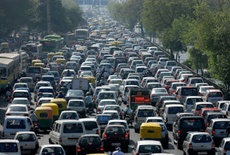Singapore to ban new cars from February
24 Oct 2017
Singapore, already one of the world's most expensive places to own a vehicle, will not allow any increase in the number of cars on its roads from February.
 Citing the city-state's land scarcity and billions of dollars in planned public transport investments, the Land Transport Authority (LTA) said it was cutting the permissible vehicle growth rate in the city-state to 0 per cent from the current 0.25 per cent per annum for cars and motorcycles. The rate will be reviewed in 2020.
Citing the city-state's land scarcity and billions of dollars in planned public transport investments, the Land Transport Authority (LTA) said it was cutting the permissible vehicle growth rate in the city-state to 0 per cent from the current 0.25 per cent per annum for cars and motorcycles. The rate will be reviewed in 2020.
''In view of land constraints and competing needs, there is limited scope for further expansion of the road network," the Land Transport Authority said in a statement on its website. Roads already account for 12 per cent of the city-state's total land area, it said.
Land in Singapore - Smaller than New York City - is a precious commodity and officials want to ensure the most productive use of the remaining space. Its infrastructure is among the world's most efficient, and the government is investing S$28 billion ($21 billion) more on rail and bus transportation over the next five years, the regulator said.
Singapore tightly controls its vehicle population by setting an annual growth rate and through a system of bidding for the right to own and use a vehicle for a limited number of years. It is one of the most densely populated nations on the planet and already has an extensive public transport system.
Singapore requires car owners to buy permits called Certificates of Entitlement that allow holders to own their vehicles for 10 years. These permits are limited in supply and auctioned monthly by the government. At the most recent offering last week, the permit cost S$41,617 for the smallest vehicles.
Singapore, whose total population has risen nearly 40 per cent since 2000 to about 5.6 million now, counted more than 600,000 private and rental cars on its roads as of last year. These include cars used by drivers that work with ride-hailing services such as Grab and Uber, which are becoming increasingly popular.
A mid-range car in Singapore can typically cost four times the price in the United States.
The LTA said the zero-growth target will affect vehicles in Categories A, B and D under its permit system -- these include cars and motorcycles. The existing vehicle growth rate of goods vehicles and buses will remain at 0.25 per cent per annum until March 2021 to give businesses time to improve the efficiency of their operations and reduce the number of commercial vehicles they require.
Singapore has expanded its rail network length by 30 per cent and has added new routes and capacity in its bus network. The government will continue to invest S$20 billion ($14.7 billion) in new rail infrastructure, S$4 billion to renew, upgrade and expand rail operating assets, and another S$4 billion in bus contracting subsidies over the next five years, the LTA said.
The LTA will keep the growth rate for goods vehicles and buses at 0.25 per cent until the first quarter of 2021.













.jpg)






.jpg)









